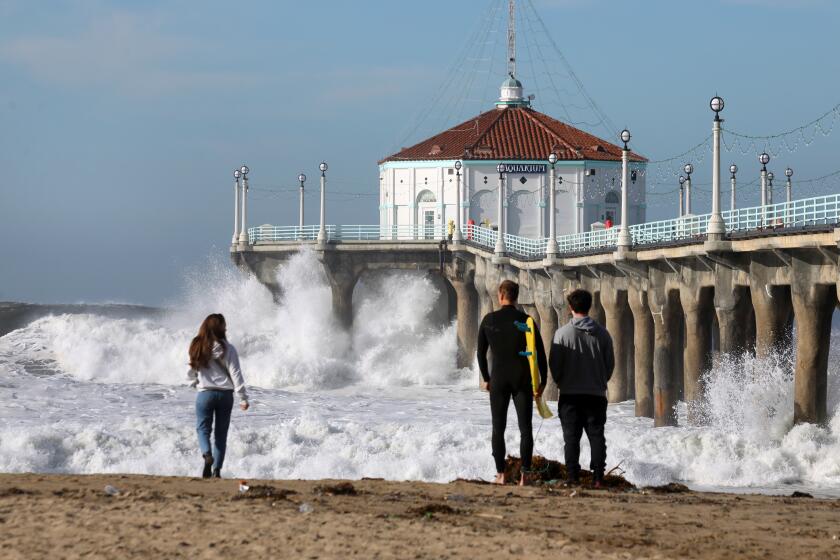Column: It’s flooding in Southern California. 85 years ago, the damage was way worse
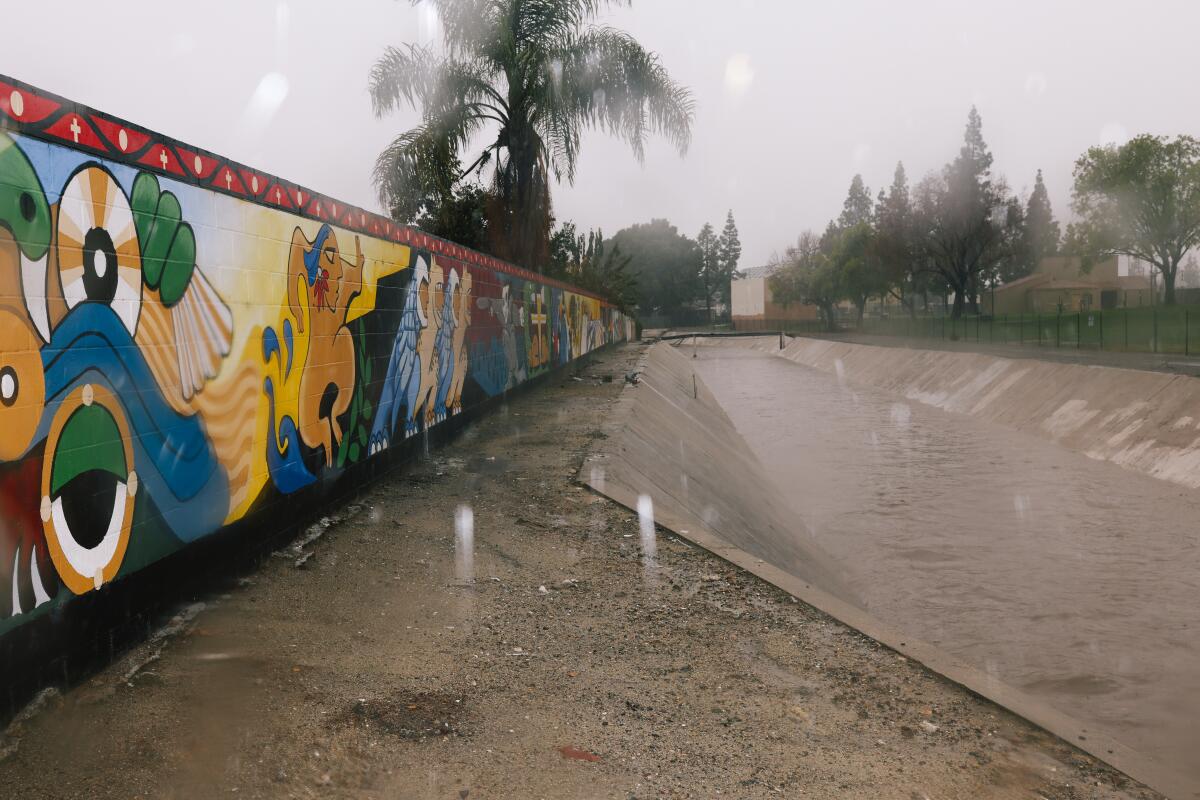
My umbrella was wide and sturdy, my rain slicker insulated and as yellow as a Minion. I wore thick Dickies and my good pair of Doc Martens.
It didn’t matter. Just minutes after I stepped out of my Yukon to walk around Parque de los Niños in Placentia’s Atwood barrio last week, I was thoroughly soaked.
A strong wind made the rain whip at a 45-degree angle. Drops hit the baseball diamond with such force that mud leaped into the air.
At the southern edge of the small park, the water in the Atwood Channel usually amounts to little more than a puddle. But by 9 a.m. that day, with rain coming down hard but not as hard as forecasters had predicted, the concrete wash was a roaring rapids, and rising fast.
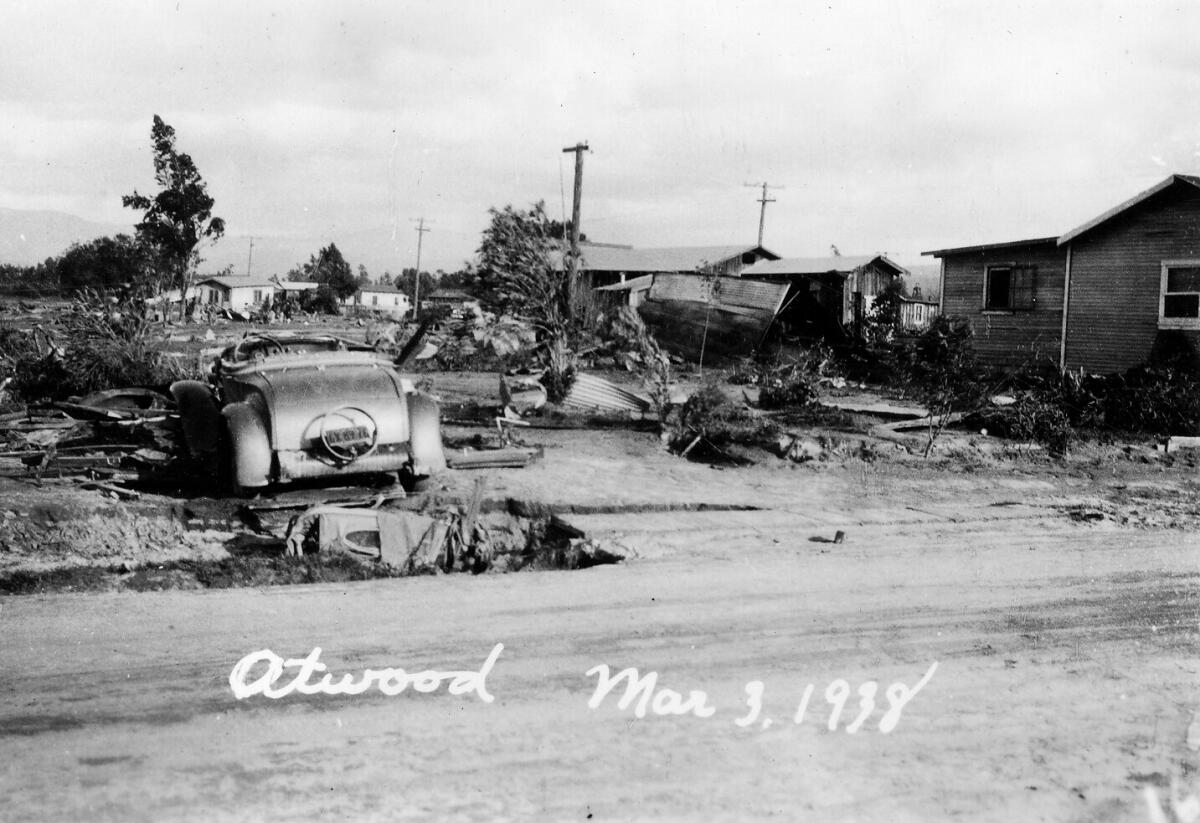
Eighty-five years ago this March, this historic Mexican American neighborhood took the brunt of the deadliest flood in Southern California history. Five days of heavy storms caused all of the region’s major rivers — the Los Angeles, the San Gabriel and especially the Santa Ana — to overflow their banks.
Bridges bent like wet noodles. Houses crumbled. Motorboats puttered through downtown Los Angeles. The area from Placentia to Santa Ana turned into a shallow lake. Thousands were left homeless. Regionally, the Army Corps of Engineers estimated that the disaster inflicted $78.6 million in damage — $1.7 billion in today’s money — and killed 87 people, with another nine reported missing.
Nearly half of the dead — 43, according to historians — were from Atwood.
I’ve known about the Great Flood of 1938 since childhood. Its devastation was a part of our collective memory in Anaheim growing up in the 1980s — taught to schoolchildren, remembered by elders. It’s been on my mind all month — not just because of the upcoming 85th anniversary, and not even because of the parade of storms that has unleashed historic rain and snow across California.
What keeps me thinking about the catastrophe is too many social media posts wondering why our forefathers paved over Southern California’s rivers, streams and creeks to make it easier for rainwater to rush out toward the Pacific, instead of figuring out how to retain all that precipitation.
The answer is the Great Flood of 1938.
Civic leaders embarked on a decades-long campaign to build dams, flood-control channels, reservoirs and water basins to guard against something like that ever happening again.
In fact, the Corps of Engineers didn’t deem the Santa Ana River safe from a 100-year-flood until the 1999 completion of the Seven Oaks Dam in the San Bernardino Mountains.
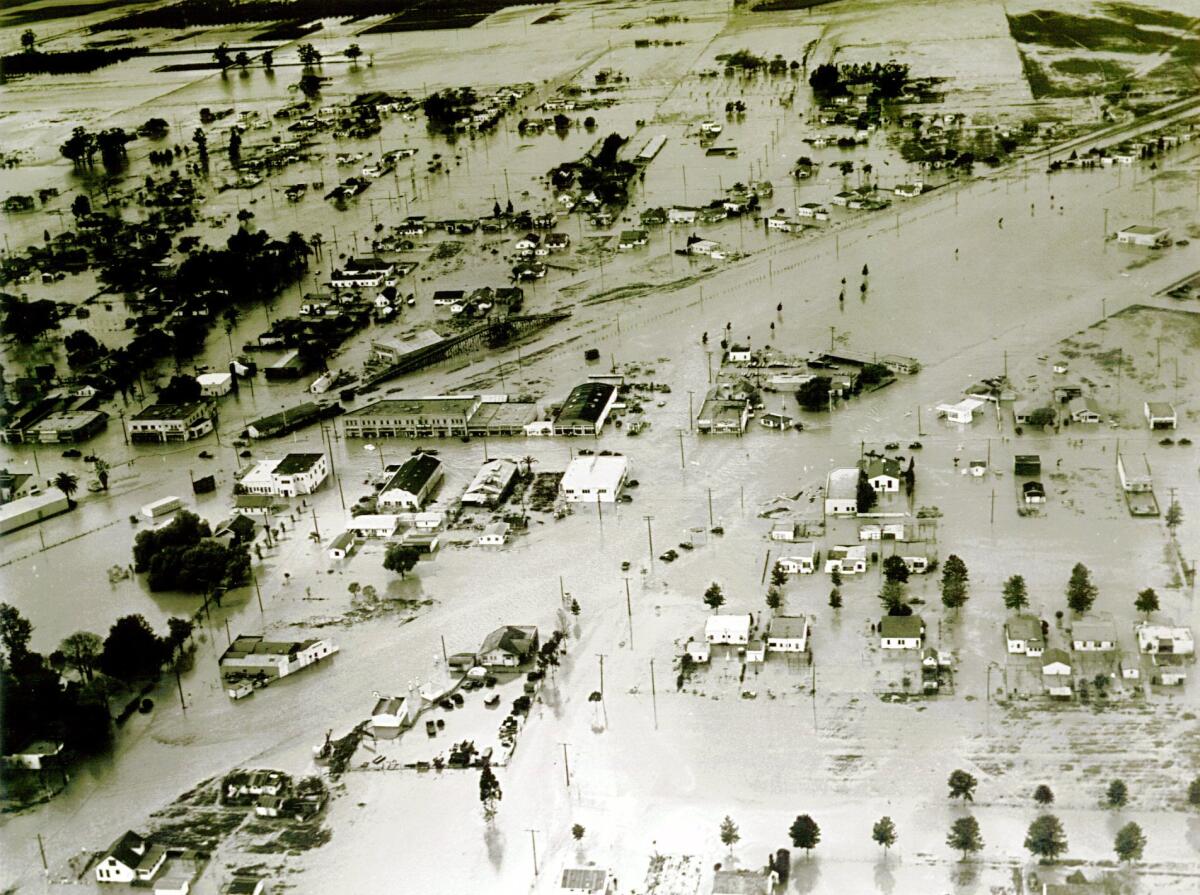
)
We’ve collectively lived free from a catastrophic flood because of all this infrastructure. Yet the only explicit monuments to the Great Flood of 1938 are in northern Orange County, in places like Atwood. So I made it a point to visit them on a stormy day.
This week, heavy rains pummeled the state again. Back-to-back storms have killed at least 19, and damage could reach or exceed $1 billion. In the L.A. area, some neighborhoods flooded, but the rivers stayed contained in their concrete channels.
More storms are expected through January.
No one was outside as I walked around Parque de los Niños for about half an hour in the lashing rain. There was no marker to commemorate Atwood’s flood victims in the playground or outside the community center. I walked toward a massive, recently restored Chicano mural on the brick wall that separates houses from the barrio’s flood-control channel. Maybe there was an homage hidden among the images of Aztec warriors and Spanish conquistadors.
As California is pummeled by a string of atmospheric rivers, efforts to capture and treat stormwater face many hurdles.
Halfway through the mural, I finally saw it: a section that featured people being washed away by black waves and a bright blue river.
The Atwood Channel runs parallel to Orangethorpe Avenue, which took me to my next stop: Melrose Elementary in Placentia’s La Jolla barrio.
This used to be the site of La Jolla School, a Mexican-only academy set up in the era of segregation. On the night of the Great Flood, Principal Chester Whitten went through the neighborhood urging residents to take shelter on the campus. About 400 people spent the night perched on tables and chairs as the floodwaters rose. Six La Jolla residents perished.
A plaque at the base of a group of flagpoles recounts this story. The Melrose school bell sounded as I read the inscription, but no students rushed out of their classrooms — it was still winter break.
So I went next door to the Whitten Community Center. On the short walk, I noticed that a swollen flood-control channel separated the school from the center.
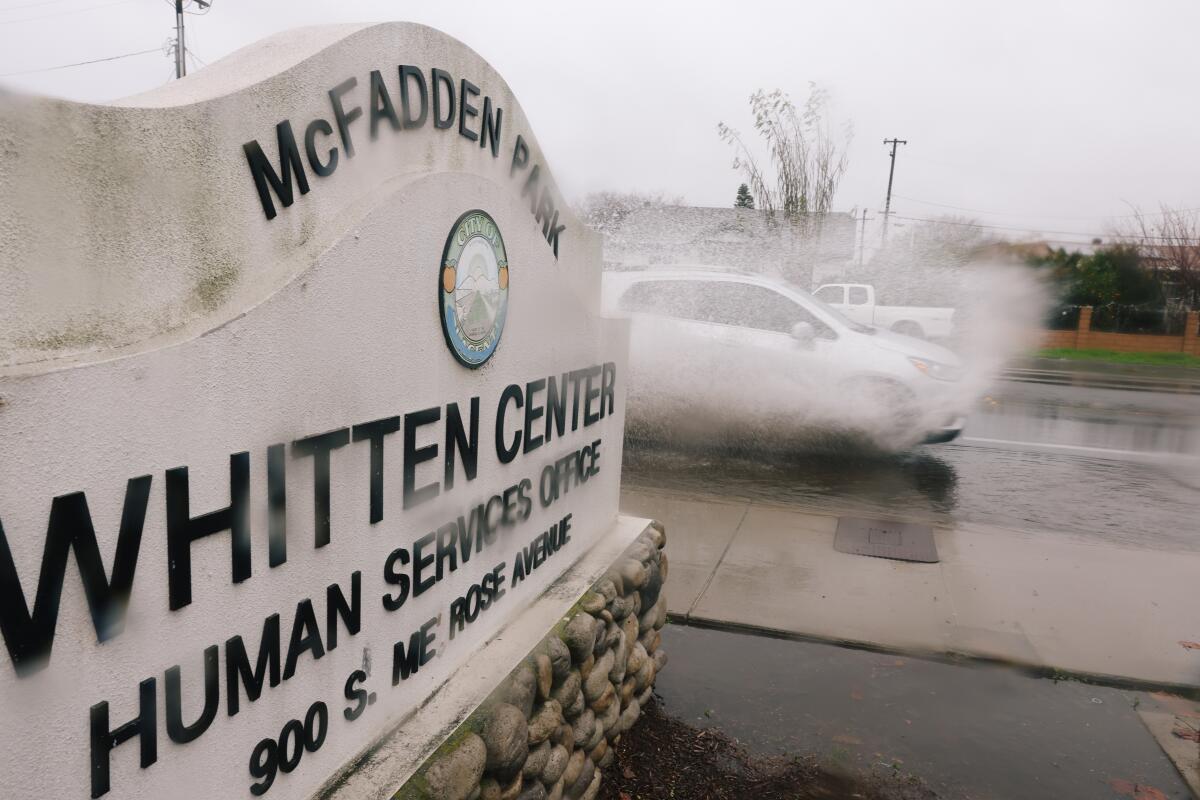
Inside the low-slung facility, I met a group of young Placentia municipal workers. I asked if any of them had heard of the Great Flood of 1938. None had. When I told them about the ruin it caused, their jovial tone turned serious. When I mentioned Whitten’s heroism, their eyes sparkled with pride.
Then, 24-year-old Nalani Furumoto spoke up. “I do know about it!” she exclaimed. “I saw a video on YouTube.”
When I asked if the Whitten Center had any mementos of its namesake — maybe something in a display case, or a poster — Furumoto said, “Didn’t we used to have a framed photo of him?”
She asked if anyone wanted to look for it. No one did.
My tour ended in my hometown, at the Anaheim Central Library. This is where I spent much of my childhood and where I first learned about the Great Flood of 1938.
Sixty years ago this month a massive flood swept Orange County with a destructive force that makes El Nino look muy pequeno.
For decades, a 1920s-era wooden Pinocchio doll — think the skinny stick figure in Guillermo del Toro’s version of the tale, not the cherubic kid in the Disney animated classic — has watched over the library’s children’s room from a rocking chair.
As kids, we were taught about how Pinocchio survived the Great Flood of 1938 while his caretakers drowned. But stories come and go, and I didn’t see Pinocchio in his usual spot. I was afraid the staff had exiled him to storage in favor of newer myths like Captain Underpants or Paw Patrol.
Librarian Angelica Sauceda Garcia pointed me in the right direction: near a poster of a waving Arthur from the beloved PBS cartoon. Pinocchio was as reassuring as I remembered and looked the same, save for black construction paper wedged at the bottom of his chair.
“So he doesn’t fall off when there’s earthquakes,” Sauceda Garcia said with a chuckle.
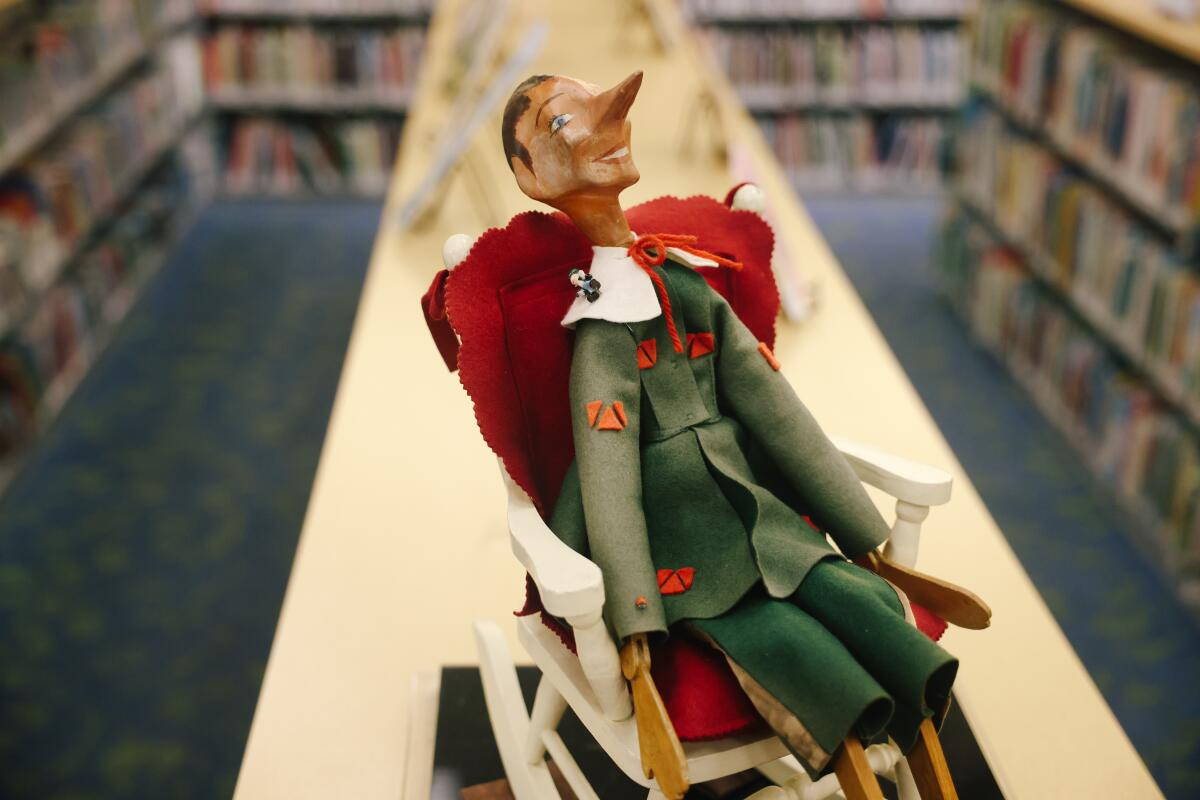
“People come looking for him all the time,” she continued. “He’s a hero.”
Sauceda Garcia tells Pinocchio’s flood story any time children take tours of the Central Library. David and Lenora Swanson owned a doll hospital and were sprucing up Pinocchio — who had suffered a cracked head, broken nose and busted leg during the 1933 Long Beach earthquake — for Anaheim’s children’s librarian, Elva Haskett, when the Great Flood hit. The Swansons drowned when floodwaters submerged their car, along with Pinocchio.
“Telling them that shows them that this [the flood] was real,” the librarian said. “People died. So they’re always very impressed by [Pinocchio]. He encourages them to be brave.”
The rain had stopped when I stepped outside again. The sun was beginning to break through.
What Southern California has weathered so far this January has been bad but nowhere near as destructive as 1938. Lest I forget that, a reminder waited as I neared the Orange Crush on the 5 Freeway South.
Below me was the Santa Ana River. It was flowing. Fast.
More to Read
Sign up for Essential California
The most important California stories and recommendations in your inbox every morning.
You may occasionally receive promotional content from the Los Angeles Times.
